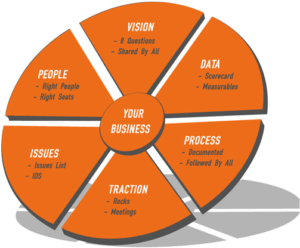Every entrepreneur has a vision of what they want their business to look like. We all have goals and dreams for the “next step” in our business. But how do we get there quickly, without wasting excess time, energy, and money? That is where EOS®, the Entrepreneurial Operating System for small businesses, steps up. To help you bring your company to the next level, we spoke to a Professional EOS® Implementer for her top tips!
What Is EOS® And Who Is Lisa Manning?
 EOS®, the Entrepreneurial Operating System, is a set of simple tools and concepts that help entrepreneurs and small business owners focus their goals, assemble the right team and achieve profitable growth. Based on founder Gino Wickman’s popular book, Traction: Get a Grip on Your Business, the system has an incredible success rate of helping companies reach the next level.
EOS®, the Entrepreneurial Operating System, is a set of simple tools and concepts that help entrepreneurs and small business owners focus their goals, assemble the right team and achieve profitable growth. Based on founder Gino Wickman’s popular book, Traction: Get a Grip on Your Business, the system has an incredible success rate of helping companies reach the next level.
EOS® has a network of certified Implementers, or consultants, that can help businesses put the system into action. Lisa Manning has been a full-time Professional Implementer for EOS® for multiple years, focusing on companies with 10-250 employees.
Lisa was introduced to EOS® when she implemented it at a family business where she was COO. After implementation, the business grew top line revenue 30%-50% per year! She was hooked and knew EOS® would be her “passion for life!”
How To Find Great Team Members
 The first step to achieving your business goals is to have the right team on board. When I asked Lisa about finding the right people to grow your organization she told me, “one of the masterful elements of EOS® is teaching that it is not enough that people possess the talent to do the job. This is known as the Right Seat. Equally as important is that they be the Right People, meaning they possess the core values of the company.”
The first step to achieving your business goals is to have the right team on board. When I asked Lisa about finding the right people to grow your organization she told me, “one of the masterful elements of EOS® is teaching that it is not enough that people possess the talent to do the job. This is known as the Right Seat. Equally as important is that they be the Right People, meaning they possess the core values of the company.”
Every small business wants employees who are committed to their vision and values. But finding those people means discovering what values drew the leadership team together. As Lisa says, “What characteristics define your three key employees? Those are your core values.” The tricky part comes in implementing those core values. Once discovered, the leadership team has to be willing to hire, fire and review to those core values.
To make this process easier, EOS® relies on an Accountability Chart. This structure outlines what boxes you need to fill, and the five critical responsibilities of each box that are necessary to run the company. Then, you can hire and fire based on your chart. Does every employee possess your core values and are they in the right seat for their skills?
In Lisa’s experience, “most companies settle. They keep people around for years and years because of the notion that they can’t find better people. It’s not good enough. You want to see a change in your growth and productivity—address your Right People, Right Seat issues. It’s a game changer. Don’t settle.”
Handling Family Member Employees
When it comes to employing family members, Lisa encourages entrepreneurs to focus on business structure first and people second. Family or not, they have to fit the seat! It may sound harsh, but Lisa’s advice is to, “get the best people in the right seats and make sure they can demonstrate your core values. Or get them off the bus!”
And remember, just because a family member is part owner doesn’t guarantee them a spot in day-to-day operations. Lisa recommends separating owners from what is best for the company. “Think of a professional baseball team,” she told me, “Does the owner play first base? No, the best person for the job plays first base as that is in the best interest of the team.” If an owner can’t check all the accountability boxes for a role, they may need to step back into the owner’s box.
Build Traction Towards Your Goals
 Once you have your team and vision in place, EOS® focuses on getting the team working efficiently and productively towards the company’s goals. They refer to this as building “Traction.” Lisa defines Traction as, “gaining the discipline and accountability to achieve the Vision.” In EOS®, you build Traction by having measurable, defined goals and holding effective regular meetings.
Once you have your team and vision in place, EOS® focuses on getting the team working efficiently and productively towards the company’s goals. They refer to this as building “Traction.” Lisa defines Traction as, “gaining the discipline and accountability to achieve the Vision.” In EOS®, you build Traction by having measurable, defined goals and holding effective regular meetings.
Define Your “Rocks”
Long-term business goals are a fantastic tool, but it’s almost impossible to keep a team motivated and focused on some achievement point years ahead. In the next year, your business’ landscape might change, employees might leave or goals may shift. So, EOS® places its emphasis on 90-day “Rocks.”
According to Lisa, your company’s Rocks are, “the most important priorities for the company in the next 90 days.” The program recommends setting three to seven Rocks that are specific and measurable, then staying laser-focused on completing those Rocks.
When defining these 90-day goals, remember that “less is more.” Narrow down to what is important over the next quarter, assign each Rock to the appropriate team member based on your Accountability Chart, and get to work!
Holde Effective Meetings
Staying on track with your company’s Vision and Rocks requires keeping your leadership team on the same page. EOS® recommends a meeting cadence of weekly, quarterly, and annual meetings. But these aren’t your standard, time-wasting status-update meetings. Lisa emphasizes that “all of these meetings should have very specific agendas with metrics and a high degree of accountability.”
To make sure meetings stay focused and productive, EOS® recommends making all weekly meetings “Level 10” meetings. According to Lisa, these meetings should be “self-correcting,” meaning that “every participant rates the meeting at the end on a scale of 1-10 with 10 being the best. If anyone rates it less than an 8 they need to say what the team can do better the next week to make the meeting a 10.”
If you’ve faced years of meetings where you felt the point could have been summarized in a two-sentence email, productive Level 10 meetings might sound a bit like hogwash. As a first step to holding better meetings, Lisa recommends spending, “the majority of the time focusing on problem-solving the most important issues of the week and discussing where you are off track from the plan.” Don’t waste time replaying the details of what went right or discussing any progress update without reference to your goals.
Don’t Get Bogged Down In Data
 With the advent of the internet, detailed accounting and client management software, and more it is easy for small businesses to get overwhelmed by big data. To help companies maintain focus on their Vision and gaining Traction, EOS® recommends creating a scorecard.
With the advent of the internet, detailed accounting and client management software, and more it is easy for small businesses to get overwhelmed by big data. To help companies maintain focus on their Vision and gaining Traction, EOS® recommends creating a scorecard.
Lisa explains that every leadership team should have a “13-week scorecard with 5-15 metrics, with each metric having an owner and target.” Each week, review whether you are off-track or on-track for every metric in your Level 10 meeting. But EOS® and Lisa encourage you to remember that, “if you are on-track, don’t waste precious time talking about it. If you are off-track, make sure you do talk about it!”
While it would be fantastic to share the perfect scorecard, the key metrics to track depend on your company’s unique goals. Ask yourself what activities you need to be doing to make sure you hit your revenue or cash flow target. Do you need to have ten new meetings a week with prospects? Put that on your scorecard.
In developing the perfect scorecard, Lisa mentioned that “it typically takes 2-3 months to get your scorecard to a place where you love it. If it isn’t working or you aren’t talking about red items, change it!” Your scorecard is meant to motivate and focus your team. Don’t be afraid to make changes so that it works for you.
Grow Quickly And Effectively With EOS®
Wickman’s EOS® system and book have helped thousands of businesses make the jump to the next level. It is a proven process that works by keeping things simple. Listen to Lisa’s advice and get started today by, “staying focused, doing less better, and dealing with your people issues as quickly as possible.” Growing your business isn’t easy, but it can be simple!
EOS® offers a free EOS® Toolbox of business management tools to help you start growing your business efficiently today.
Some answers have been edited for length and clarity.
image credit: Bigstock/JacobLund
Chelsea Brennan is a former Wall Street financial analyst and investment manager who changed gears in her career to chase her passion of improving financial literacy and independence. She is now a personal finance writer and content marketer. Chelsea shares her obsession with budgeting, investing, and raising financially smart kids at MamaFishSaves.com.
